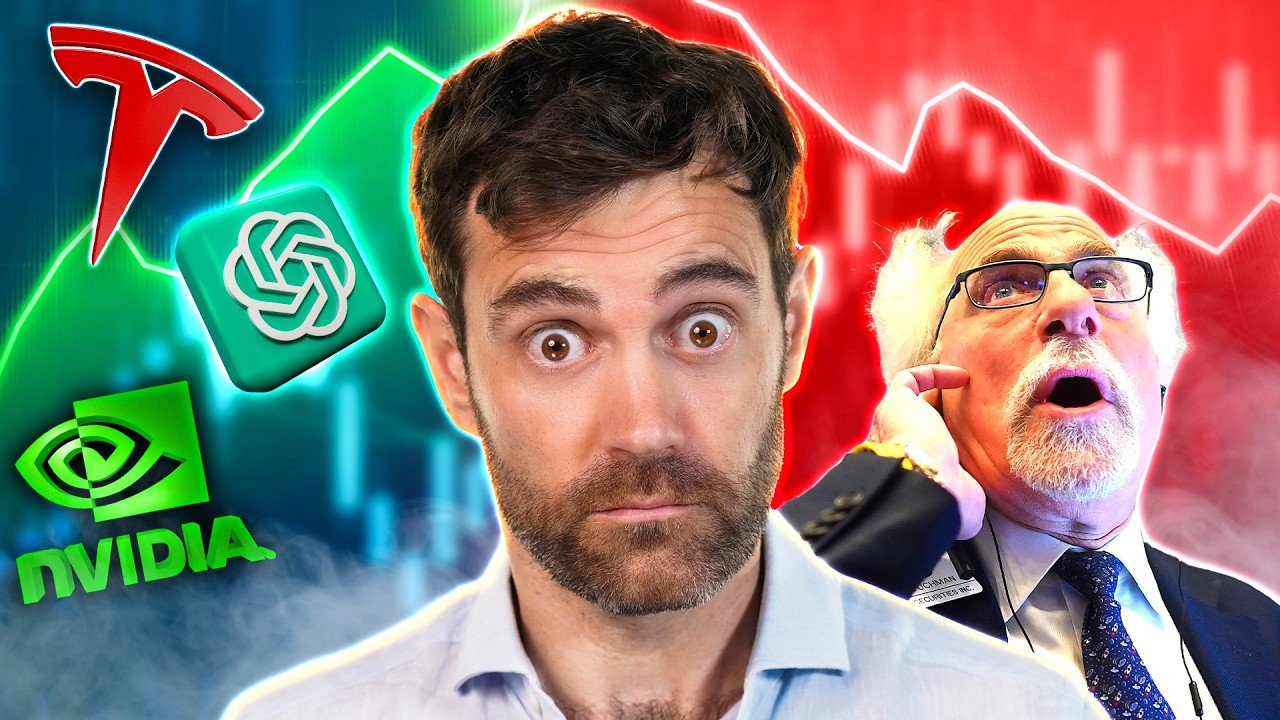The recent turmoil in global stock markets has erased $6.4 trillion in just 20 days, sparking fears of a potential bubble. Key factors contributing to this downturn include Japanese interest rates, geopolitical tensions, and recession rumors, with the initial shockwaves emanating from Silicon Valley’s tech sector.
Coin Bureau’s latest analysis tackles the implications of this potential bubble on cryptocurrency markets. The discussion covers the impact of artificial intelligence on tech stocks, shifts in market sentiment, and methodologies to assess if we’re truly in a bubble. By understanding these dynamics, you can better navigate the uncertain financial landscape and recognize how these market fluctuations might affect your crypto investments.
Stock Market Bubble Could Burst Soon?! What It Means For Crypto!

This image is property of i.ytimg.com.
Magnificent AI
Role of AI in the Current Stock Market
Artificial Intelligence (AI) has profoundly influenced the current stock market, catalyzing significant shifts in market behavior and investor strategies. The release of OpenAI’s ChatGPT in November 2022 marked a pivotal moment, generating a wave of AI enthusiasm that amplified stock values across the tech sector. Companies such as Microsoft, Alphabet, Amazon, Meta, Nvidia, Apple, and Tesla, collectively known as “The Magnificent 7,” have seen their shares soar. This boom underscores AI’s perceived potential to revolutionize diverse industries, from cloud computing to consumer services, thereby bolstering investor confidence and driving capital flows into AI-centric firms.
Impact of AI on Investor Sentiment
AI has not only reshaped market fundamentals but also profoundly impacted investor sentiment. The ascendancy of AI technologies has created a pervasive belief in their transformative potential, fostering an optimistic outlook among investors. This sentiment has propelled substantial investments into tech stocks, buoyed by the expectation of long-term gains and innovative breakthroughs. However, this fervor also carries risks. The inflated expectations around AI capabilities could lead to market corrections, especially if technological advancements fail to meet investors’ lofty ambitions.
Case Studies: Microsoft and OpenAI
Microsoft’s strategic investment in OpenAI exemplifies how major corporations are leveraging AI to gain competitive advantages. Since 2020, Microsoft has committed $13 billion to OpenAI, positioning itself as the exclusive provider of computing power for OpenAI’s projects. This collaboration aims to integrate AI into Microsoft’s suite of products, enhancing functionalities and creating new revenue streams. Despite the high operational costs associated with AI, these investments reflect a broader trend where tech giants are betting heavily on AI to secure future growth.
The Great Rotation
Shift in Market Dynamics
The recent shift in market dynamics, often referred to as “The Great Rotation,” signifies a transition from mega-cap tech stocks to small-cap stocks. This movement began in earnest in July 2023, triggered by cooler-than-expected inflation data from the U.S. Department of Labor. The prospect of upcoming interest rate cuts further fueled this trend. As high interest rates disproportionately impacted small-cap companies, the anticipated rate reductions renewed investor interest in these stocks, leading to a notable shift in investment patterns.
Investor Behavior Changes
Investor behavior has changed markedly in response to evolving economic indicators and market conditions. With the tightening of monetary policies adversely affecting growth stocks, investors have redirected their focus towards more resilient sectors. This rotation reflects a broader reassessment of risk and reward profiles, where investors are increasingly valuing stability and growth potential in smaller, undervalued companies over the previously dominant mega-cap stocks.
Small-Cap Stocks vs. Mega-Cap Stocks
Small-cap stocks, represented by indices such as the Russell 2000, have begun to outperform their mega-cap counterparts. The enhanced performance of small-cap stocks is largely attributable to their susceptibility to interest rate changes. Unlike mega-cap companies, which are insulated from economic fluctuations due to substantial cash reserves, small-cap firms stand to benefit significantly from decreased borrowing costs. This dynamic has catalyzed a reallocation of capital, enhancing the attractiveness of small-cap investments.
But is it a Bubble?
Defining a Market Bubble
A market bubble occurs when the prices of assets inflate rapidly to levels far exceeding their intrinsic value, driven by exuberant speculation rather than fundamental improvements. Typically, bubbles are characterized by an initial surge in prices, followed by an unsustainable peak and a dramatic collapse. The bursting of a bubble often results in substantial financial losses for investors, underscoring the importance of identifying and mitigating bubble risks.
Current Market Conditions
Current market conditions exhibit several characteristics typically associated with bubbles. The extraordinary valuation of tech stocks, particularly those within The Magnificent 7, raises concerns about sustainability. Fuelled by AI hype, these companies have amassed substantial market caps, often without corresponding advancements in profitability or tangible benefits. However, some analysts argue that the market’s recent movements represent a correction rather than a bubble, driven by recalibrations in investor expectations and economic realities.
Opinions from Financial Experts
Financial experts are divided on whether the current market reflects a bubble. Some caution that AI-driven speculations have created unsustainable valuations, posing risks of a significant market correction. Conversely, others assert that while certain segments may be overvalued, the broader market is merely adjusting to new economic conditions. This divergence in expert opinions highlights the complexities of predicting market trajectories, particularly in an era characterized by rapid technological advancements and economic uncertainties.
Ray’s Bubbleometer
Introduction to Ray’s Bubbleometer
Ray’s Bubbleometer is a financial tool developed to evaluate the presence and severity of market bubbles. Devised by renowned investor Ray Dalio, this analytical framework employs a set of criteria to assess whether market conditions align with those typically preceding a bubble. By examining historical data and current market trends, Ray’s Bubbleometer provides insights into potential bubble formations and helps investors navigate complex market environments.
Six Criteria for Measuring a Bubble
Ray’s Bubbleometer relies on six critical criteria to measure market bubbles:
- Price Increases Relative to Traditional Measures: Evaluating whether asset prices have surged disproportionately compared to historical benchmarks.
- Unsustainable Crowd Behavior: Assessing the degree of speculative mania and herd behavior among investors.
- New Paradigm Belief: Gauging whether there is a widespread belief that “this time is different,” justifying higher prices.
- Increased Debt Financing: Monitoring the extent to which investments are leveraged through borrowing.
- Buyers’ Belief in Continuing Price Increases: Examining the sentiment that prices will perpetually rise.
- Broad Participation: Observing whether a wide range of investors are engaging in speculative behaviors.
Current Evaluations Using the Tool
Applying Ray’s Bubbleometer to current market conditions yields mixed results. While some criteria, such as rapid price increases and broad participation, are evident in the tech sector, others, like unsustainable crowd behavior and excessive debt financing, are less pronounced. This suggests that while certain market segments may be overheated, the overall landscape does not exhibit the typical signs of a full-blown bubble. Consequently, investors should remain vigilant, balancing optimism with caution as they navigate current market conditions.

This image is property of images.pexels.com.
Stock Market Downturn
$6.4 Trillion Wiped Out
The stock market recently experienced a severe downturn, resulting in $6.4 trillion being wiped out from global stock markets within a span of 20 days. This dramatic loss underscores the inherent volatility of financial markets and the potential for significant capital erosion during periods of economic instability. The downturn was particularly marked by sharp declines in tech stocks, highlighting the fragility of sectors heavily influenced by speculative investments.
Main Causes of the Downturn
Several factors contributed to the recent market downturn:
- Japanese Interest Rates: Shifts in Japanese monetary policy and interest rates exerted pressure on global financial markets.
- Geopolitical Tensions: Ongoing geopolitical issues, including trade disputes and regional conflicts, heightened market uncertainties.
- Foreign Exchange Issues: Fluctuations in foreign exchange rates, driven by economic policies and global market dynamics, exacerbated market instability.
- Recession Rumors: Speculation about impending recessions fueled investor anxiety, triggering sell-offs and exacerbating market declines.
Timeline of Major Events
The market downturn can be traced through a timeline of key events:
- Early July 2023: Initial signs of market stress emerge, with tech stocks beginning to show signs of weakness.
- Mid-July 2023: Cooler-than-expected inflation data prompts speculation about interest rate cuts, intensifying market volatility.
- Late July 2023: A sharp decline in the market capitalization of major tech stocks initiates broader market turmoil.
- Early August 2023: The cumulative impact of economic indicators and geopolitical tensions culminates in significant market losses, wiping out trillions in market value.
Tech Stock Rally & AI Influence
Rise of Tech Stocks Due to AI Hype
The release of OpenAI’s ChatGPT sparked a significant rally in tech stocks, driven by heightened expectations of AI’s transformative impact. Major tech companies, particularly The Magnificent 7, witnessed substantial increases in their stock values as investors poured capital into AI-driven opportunities. This surge was driven by a combination of technological optimism and speculative fervor, propelling tech stocks to unprecedented heights.
The Magnificent 7 and Their Impact
The Magnificent 7—Microsoft, Alphabet, Amazon, Meta, Nvidia, Apple, and Tesla—have played a pivotal role in shaping the stock market’s trajectory. Collectively, these companies account for one-third of the S&P 500’s market capitalization, underscoring their dominance. Their substantial growth has been instrumental in driving index performance, masking broader market dynamics and creating a scenario where their valuations significantly influence overall market sentiment.
Long-term Viability of AI Investments
While AI investments have fueled remarkable short-term gains, questions persist about their long-term viability. The high operational costs associated with AI technologies, coupled with uncertainties about sustainable revenue generation, pose challenges. As AI technologies continue to evolve, the true extent of their economic impact remains to be seen, necessitating a cautious approach to long-term AI investments.

This image is property of images.pexels.com.
AI Investment Concerns
High Operational Costs
AI technologies entail substantial operational costs, driven by the need for sophisticated infrastructure, data processing capabilities, and ongoing research and development. For instance, maintaining and improving AI models like ChatGPT incurs significant expenses. These high operational costs can strain financial resources, particularly for firms heavily reliant on AI-driven strategies.
Questionable Returns on AI Investments
The economic returns on AI investments remain uncertain, largely due to the nascent stage of many AI technologies. While initial hype has propelled valuations, the tangible benefits and revenue streams from AI applications are yet to be fully realized. This uncertainty poses substantial risks for investors, necessitating a critical evaluation of the potential returns on AI investments.
Challenges Faced by Leading Companies
Leading companies in the AI space face several challenges, including technical limitations, ethical considerations, and regulatory scrutiny. The evolving nature of AI technologies requires continuous innovation, which can be resource-intensive. Additionally, ethical concerns around AI applications, such as data privacy and unbiased algorithms, necessitate careful management. Regulatory environments may also pose hurdles, impacting the deployment and scalability of AI solutions.
Market Sentiment & Rotation
Recent Declines in Major Tech Stocks
In recent months, major tech stocks, particularly those within The Magnificent 7, have faced notable declines. This trend reflects a broader reevaluation of tech stock valuations, driven by concerns about overvaluation and the sustainability of current price levels. The market’s shift towards more balanced and diversified investment strategies underscores a changing sentiment among investors.
Rally of Small-Cap Stocks
Simultaneously, small-cap stocks have experienced a rally, buoyed by positive economic indicators and shifts in investor preferences. Cooler-than-expected inflation data and the prospect of interest rate cuts have enhanced the appeal of small-cap stocks, which are more sensitive to macroeconomic trends. This rally signifies a broader rotation in market dynamics, as investors seek to capitalize on opportunities within the small-cap segment.
Impact of Economic Indicators on Market Trends
Economic indicators, such as inflation rates and interest rate forecasts, play a crucial role in shaping market trends. Recent data suggesting lower inflation has bolstered investor confidence in potential interest rate cuts, igniting a rotation from mega-cap to small-cap stocks. These economic indicators serve as critical reference points for investors, guiding decisions and influencing broader market behaviors.

This image is property of images.pexels.com.
Impact on Crypto
Correlation Between Stock and Crypto Markets
The stock and cryptocurrency markets exhibit a weak but notable correlation. Market corrections in the stock market can impact crypto assets, as investor sentiment and capital allocation strategies often overlap. During periods of stock market volatility, cryptocurrencies may experience similar fluctuations, reflecting broader risk-off sentiments among investors.
Potential Effects of Stock Market Corrections
Stock market corrections can have several potential effects on the cryptocurrency market. A downturn in traditional financial markets may prompt investors to liquidate crypto holdings to cover losses or enhance liquidity. Additionally, risk aversion during stock market corrections can dampen speculative investments in cryptocurrencies, leading to price declines and reduced trading volumes.
Investment Strategies for Crypto Enthusiasts
Crypto enthusiasts should adopt disciplined investment strategies to navigate market fluctuations. Diversifying portfolios, maintaining a long-term perspective, and validating investment theses can mitigate risks. Additionally, keeping abreast of macroeconomic indicators and stock market trends enables informed decision-making, enhancing preparedness for potential market corrections.
Conclusions
Summary of Key Points
The interplay between AI advancements and stock market dynamics has been profound, driving significant capital flows and influencing investor sentiment. The recent market rotation from mega-cap to small-cap stocks underscores shifting economic conditions and evolving investment strategies. While concerns about market bubbles persist, analytical tools like Ray’s Bubbleometer provide valuable insights into current market conditions. Understanding the nuances of AI investment concerns and market sentiment is crucial for navigating the financial landscape.
Final Thoughts on Market Outcomes
The stock market remains inherently complex, influenced by multifaceted factors ranging from technological innovations to macroeconomic indicators. While AI-driven investments present substantial opportunities, they also carry inherent risks. Investors should adopt a balanced approach, cognizant of the potential for market corrections and the evolving nature of financial markets. Staying informed and adaptable is paramount in managing the uncertainties and opportunities that characterize the current environment.
How to Stay Informed and Prepared
To stay informed and prepared, investors should continuously monitor market trends, economic indicators, and technological advancements. Engaging with credible financial analysis, participating in market discussions, and leveraging analytical tools can enhance decision-making. By maintaining a proactive and informed stance, investors can better navigate market complexities and capitalize on emerging opportunities.
Disclaimer: The content of this article is for informational purposes only and does not constitute financial, legal, or tax advice. Opinions expressed herein are solely those of the speaker and do not reflect the views of a licensed financial advisor. Trading cryptocurrencies involves significant risk, and readers should conduct their own research before making any investment decisions.